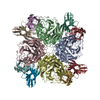+Search query
-Structure paper
| Title | Human anti-N1 monoclonal antibodies elicited by pandemic H1N1 virus infection broadly inhibit HxN1 viruses in vitro and in vivo. |
|---|---|
| Journal, issue, pages | Immunity, Vol. 56, Issue 8, Page 1927-11938.e8, Year 2023 |
| Publish date | Aug 8, 2023 |
 Authors Authors | Lena Hansen / Meagan McMahon / Hannah L Turner / Xueyong Zhu / Jackson S Turner / Gabriel Ozorowski / Daniel Stadlbauer / Juha Vahokoski / Aaron J Schmitz / Amena A Rizk / Wafaa B Alsoussi / Shirin Strohmeier / Wenli Yu / José Alberto Choreño-Parra / Luis Jiménez-Alvarez / Alfredo Cruz-Lagunas / Joaquín Zúñiga / Philip A Mudd / Rebecca J Cox / Ian A Wilson / Andrew B Ward / Ali H Ellebedy / Florian Krammer /    |
| PubMed Abstract | Neuraminidase (NA) is one of the two influenza virus surface glycoproteins, and antibodies that target it are an independent correlate of protection. However, our current understanding of NA ...Neuraminidase (NA) is one of the two influenza virus surface glycoproteins, and antibodies that target it are an independent correlate of protection. However, our current understanding of NA antigenicity is incomplete. Here, we describe human monoclonal antibodies (mAbs) from a patient with a pandemic H1N1 virus infection in 2009. Two mAbs exhibited broad reactivity and inhibited NA enzyme activity of seasonal H1N1 viruses circulating before and after 2009, as well as viruses with avian or swine N1s. The mAbs provided robust protection from lethal challenge with human H1N1 and avian H5N1 viruses in mice, and both target an epitope on the lateral face of NA. In summary, we identified two broadly protective NA antibodies that share a novel epitope, inhibited NA activity, and provide protection against virus challenge in mice. Our work reaffirms that NA should be included as a target in future broadly protective or universal influenza virus vaccines. |
 External links External links |  Immunity / Immunity /  PubMed:37506693 / PubMed:37506693 /  PubMed Central PubMed Central |
| Methods | EM (single particle) / X-ray diffraction |
| Resolution | 2.2 - 3.1 Å |
| Structure data | EMDB-27920, PDB-8e6j: EMDB-27921, PDB-8e6k:  PDB-8eqa:  PDB-8eqc: |
| Chemicals |  ChemComp-NAG:  ChemComp-ZN:  ChemComp-HOH:  ChemComp-PO4: |
| Source |
|
 Keywords Keywords |  VIRAL PROTEIN / VIRAL PROTEIN /  influenza / influenza /  monoclonal antibody / monoclonal antibody /  H1N1 / cross-reactive antibody / H1N1 / cross-reactive antibody /  IMMUNE SYSTEM / IMMUNE SYSTEM /  antibody / antibody /  neuraminidase / broad protection / neuraminidase / broad protection /  pandemic pandemic |
 Movie
Movie Controller
Controller Structure viewers
Structure viewers About Yorodumi Papers
About Yorodumi Papers









